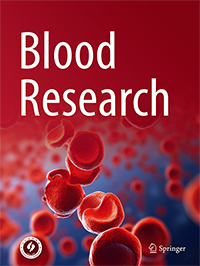Case Report
 Split Viewer
Split Viewer
Korean J Hematol 2010; 45(4):
Published online December 31, 2010
https://doi.org/10.5045/kjh.2010.45.4.279
© The Korean Society of Hematology
Wernicke's encephalopathy following allogeneic hematopoietic stem cell transplantation
Department of Internal Medicine, Korea University Medical Center, Seoul, Korea.
Correspondence to : Correspondence to Chul Won Choi, M.D., Ph.D. Department of Internal Medicine, Korea University Guro Hospital, 97, Guro-dong-gil, Guro-gu, Seoul 152-703, Korea. Tel: +82-2-2626-3058, Fax: +82-2-866-1643, bonnie@korea.ac.kr
This is an Open Access article distributed under the terms of the Creative Commons Attribution Non-Commercial License (http://creativecommons.org/licenses/by-nc/3.0/) which permits unrestricted non-commercial use, distribution, and reproduction in any medium, provided the original work is properly cited.
Wernicke's encephalopathy is caused by thiamine deficiency, and is characterized by acute mental confusion, ataxia, and ophthalmoplegia. It is also a rare neurologic complication of hematopoietic stem cell transplantation (HSCT). However, because of its rare incidence, Wernicke's encephalopathy can easily be overlooked in HSCT patients, and a few misleading steps in the early stage of the disease may result in permanent neurologic disability or even mortality. We recently encountered a case of Wernicke's encephalopathy in a patient who underwent allogeneic HSCT. Based on our own experience and previously published documents, we suggest early radiologic surveillance and treatment for patients with findings compatible with Wernicke's encephalopathy following HSCT.
Keywords Wernicke's encephalopathy, Hematopoietic stem cell transplantation, Thiamine
Article
Case Report
Korean J Hematol 2010; 45(4): 279-281
Published online December 31, 2010 https://doi.org/10.5045/kjh.2010.45.4.279
Copyright © The Korean Society of Hematology.
Wernicke's encephalopathy following allogeneic hematopoietic stem cell transplantation
Yoon Ji Choi, Seh Jong Park, Jung Sun Kim, Eun Joo Kang, Chul Won Choi*, and Byung Soo Kim
Department of Internal Medicine, Korea University Medical Center, Seoul, Korea.
Correspondence to: Correspondence to Chul Won Choi, M.D., Ph.D. Department of Internal Medicine, Korea University Guro Hospital, 97, Guro-dong-gil, Guro-gu, Seoul 152-703, Korea. Tel: +82-2-2626-3058, Fax: +82-2-866-1643, bonnie@korea.ac.kr
This is an Open Access article distributed under the terms of the Creative Commons Attribution Non-Commercial License (http://creativecommons.org/licenses/by-nc/3.0/) which permits unrestricted non-commercial use, distribution, and reproduction in any medium, provided the original work is properly cited.
Abstract
Wernicke's encephalopathy is caused by thiamine deficiency, and is characterized by acute mental confusion, ataxia, and ophthalmoplegia. It is also a rare neurologic complication of hematopoietic stem cell transplantation (HSCT). However, because of its rare incidence, Wernicke's encephalopathy can easily be overlooked in HSCT patients, and a few misleading steps in the early stage of the disease may result in permanent neurologic disability or even mortality. We recently encountered a case of Wernicke's encephalopathy in a patient who underwent allogeneic HSCT. Based on our own experience and previously published documents, we suggest early radiologic surveillance and treatment for patients with findings compatible with Wernicke's encephalopathy following HSCT.
Keywords: Wernicke's encephalopathy, Hematopoietic stem cell transplantation, Thiamine
Fig 1.

-
Table 1 . Previous reports on HSCT-associated Wernicke's encephalopathy..
Abbreviations: HSCT, hematopoietic stem cell transplantation; WE, Wernicke's encephalopathy; Auto, autologous; TPN, total parenteral nutrition; Allo, allogeneic..

Article Tools
Stats or Metrics
Related articles in BR
-
Transfusion support in hematopoietic stem cell transplantation
Dong Wook Jekarl, Jae Kwon Kim, Jay Ho Han, Howon Lee, Jaeeun Yoo, Jihyang Lim, Yonggoo Kim
Blood Res 2023; 58(S1): S1-S7 -
Prognostic impact of total body irradiation dose in pediatric acute lymphoblastic leukemia patients treated with allogeneic hematopoietic stem cell transplantation in second complete remission
Wonjin Jang, Suejung Jo, Jae Won Yoo, Seongkoo Kim, Jae Wook Lee, Pil-Sang Jang, Nack-Gyun Chung, Bin Cho
Blood Res 2022; 57(4): 256-263 -
Reduced-intensity conditioning versus myeloablative conditioning allogeneic stem cell transplantation for patients with myelofibrosis
Dong Hyun Kim, Jeongmin Seo, Dong-Yeop Shin, Youngil Koh, Junshik Hong, Inho Kim, Sung-Soo Yoon, Ja Min Byun
Blood Res 2022; 57(4): 264-271




 PDF
PDF Standard view
Standard view Export citation
Export citation Share
Share  Download
Download Previous Article
Previous Article



